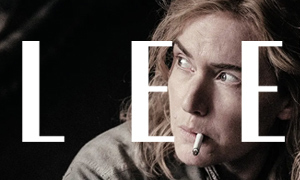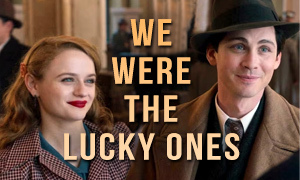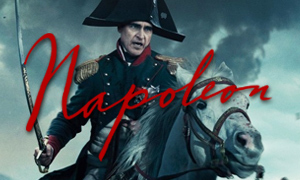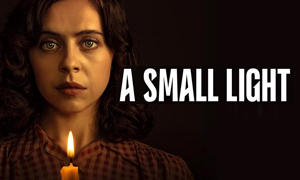The Zookeeper's Wife: History vs. Hollywood
| REEL FACE: | REAL FACE: |
Jessica Chastain
Born: March 24, 1977 Birthplace: Sacramento, California, USA | Antonina Zabinski
Born: 1908 Birthplace: Warsaw, Poland Death: 1971 |
Johan Heldenbergh
Born: May 11, 1967 Birthplace: Wilrijk, Flanders, Belgium | Jan Zabinski
Born: April 8, 1897 Birthplace: Warsaw, Poland Death: July 26, 1974, Warsaw, Poland |
Daniel Brühl
Born: June 16, 1978 Birthplace: Barcelona, Barcelona, Catalonia, Spain | Lutz Heck
Born: April 23, 1892 Birthplace: Berlin, Germany Death: April 6, 1983, Berlin, Germany |
Efrat Dor
Born: January 6, 1983 Birthplace: Beersheba, Israel | Magdalena "Magda" Gross
Born: January 18, 1891 Birthplace: Warsaw, Poland Death: June 17, 1948, Warsaw, Poland |
Martha Issová
Born: March 22, 1981 Birthplace: Prague, Czechoslovakia | Regina Kenigswein
Birthplace: Warsaw, Poland |
Martin Hofmann
Born: March 31, 1978 Birthplace: Ceské Budejovice, Czechoslovakia | Szymon Tenenbaum
Death: November 1941, Warsaw Ghetto, Poland |
What were Jan and Antonina Zabinski's exact roles at the Warsaw Zoo?
Prior to and during WWII, Antonina's husband Jan was the director and organizer of the Warsaw Zoo, one of the largest zoos in Europe at the time. He was a zoologist and zootechnician by trade, in addition to being a scientist and an author of books about biology and animal psychology. During the occupation of Poland he also held the title of superintendent of the city's public parks from 1939-1945. His job with the parks gave him the opportunity to enter the Warsaw Ghetto to inspect the flora there, while at the same time connecting with prewar Jewish friends and colleagues to help them escape.
The Zookeeper's Wife true story reveals that Antonina Zabinski was a teacher and respected author who published children's books about animals. She also had an affinity for the piano and painting. She assisted with the day-to-day operations at the zoo, including caring for the animals. During the occupation, she and their young son Ryszard fed and cared for the fleeing Jews who they had given shelter to at the zoo. Author Diane Ackerman drew in part from Antonina's diary for her book on which the movie is based.
Were Antonina and Jan Zabinski atheists?
Jan was but his wife was not. The real Zookeeper's Wife, Antonina (born Antonina Erdman), was a Russian-born Pole who lost her parents in the early days of the Russian Revolution at the hands of the Bolsheviks. She was raised a strict Catholic and both of her children (Ryszard and Teresa) were baptized. She always wore a religious medallion around her neck and it is believed that she prayed.
Her husband Jan was a bit of an anomaly, a Polish Catholic raised in a working-class Jewish neighborhood with a devoutly Catholic mother and a father who brought him up as a firm atheist. Taking after his father, Jan frowned upon religion. Together, Antonina and Jan leaned more toward a Bohemian lifestyle, often surrounding themselves with artists and intellectuals. -WashingtonPost.com
Can I read Antonina Zabinski's diary?
Author Diane Ackerman based her book largely on Antonina Zabinski's diary (memoir), which Ackerman discovered during her initial research. Antonina's memoir was published in 1968 under the title Ludzie i zwierzęta (People and Animals). Diane Ackerman's Zookeeper's Wife book is filled with quotes from Atonina's diary and loose notes, in addition to quotes from the interviews and postwar testimony of others. There is currently no English language version of Antonina's diary, but Ackerman's book includes plenty.
Was Antonina and Jan's home filled with animals?
Yes. A rotating variety of animals could often be found in the Zabinski home, including a wolf cub, a chimpanzee, a lion kitten, a kissing rabbit named Wicek, and a muskrat. Of course, they also had more conventional animals too, including their "sluttish" cat Balbina. -WashingtonPost.com
Was the damage to the Warsaw Zoo as bad as what's seen in the movie?
Yes. In researching The Zookeeper's Wife true story, we learned that the Nazis' September 1939 invasion of Poland and bombing of Warsaw left much of the zoo destroyed. In her book, Diane Ackerman describes the damage to the zoo in grave detail, stating, "The sky broke open and whistling fire hurtled down, cages exploded, moats rained upward, iron bars squealed. . . . Wounded zebras ran, ribboned with blood, terrified howler monkeys and orangutans dashed caterwauling into the trees and bushes, snakes slithered loose, and crocodiles pushed onto their toes and trotted at speed." She goes on to describe the shocking sight of two giraffes laying dead on the ground with their legs twisted, and the sound of birds and monkeys screeching in a chorus of madness. Surviving animals fled from burning cages and some were burned to death. One reason that the zoo was targeted was due to a Polish anti-aircraft battery being located nearby.
Was Jan Zabinski really a member of the Polish resistance?
Yes, Jan was a member of the resistance from the beginning. He acted as a biology teacher at an underground university. He used the zoo as a weapons depot and smuggled food into the Warsaw Ghetto and people out. After the war, Antonina learned that her husband Jan, a lieutenant in the resistance, was more deeply involved than she had realized, finding out that he was also sabotaging trains, building bombs, and poisoning the pork that was being sent to the German soldiers. For another engaging look at resistance fighters in WWII, check out our research into the movie Anthropoid. -WashingtonPost.com
Is Daniel Brühl's character, Lutz Heck, based on a real person?
Yes. The real Lutz Heck was the renowned director of the Berlin Zoo and a prewar colleague of Jan Zabinski. Supported by leading Nazi member Hermann Göring, Heck set out to eliminate animals the Nazis deemed racially degenerate, much like the Nazis' plan for humans. His ultimate goal was to use selective breeding to resurrect extinct purebred animals. Through this "breeding back," Heck created breeds of horse and cattle, which were later termed "Heck horse" and "Heck cattle." Though Heck believed these horse and cattle were nearly identical in phenotype to certain extinct species, today they are not seen as a successful resurrection. -WashingtonPost.com
Did they really hide their "guests" in the zoo's animal cages?
Yes. The Nazi bombing of Warsaw in September 1939 left the zoo severely damaged and many of its cages emptied of animals. The Zookeeper's Wife true story confirms that the Zabinskis used the cages to hide fleeing Jews and partisans. They also hid them in the underground pathways connecting the animal cages. Jan and Antonina even welcomed close to a dozen Jews into their two-story home on the zoo's grounds, hiding them in rooms and closets. Regardless of the ever-present danger they were placing themselves in, Antonina was insistent on keeping a festive, music-filled atmosphere throughout their Bauhaus-style villa. It was a much needed distraction from the ongoing threat of the Nazis learning their secret, which would invariably lead to torture and death, not just for them but for their young son Ryszard as well. -WashingtonPost.com
Did German Lutz Heck really have a crush on Antonina?
Yes. In The Zookeeper's Wife movie, Nazi Lutz Heck (Daniel Brühl) protects the couple in part because he has a crush on Antonina (Jessica Chastain). In real life, Heck, a fellow zoologist, had been a former colleague of Antonina's husband Jan. They had regularly seen Heck at annual meetings of the International Association of Zoo Directors. In The Zookeeper's Wife book, Diane Ackerman writes that the men at the meetings were impressed by Antonina's "smarts and willowy looks," including Heck who was "sweet on Antonina." She goes on to say that Antonina wondered if Heck wanted to help them so that she would see him as her medieval knight coming to protect her, a romantic gesture to "win her heart and prove his nobility." Antonina had heard from a mutual friend that she had reminded Heck of the first woman he truly loved.
Did Nazi Lutz Heck and his SS friends really kill animals at the Warsaw Zoo for fun?
Yes. According to Diane Ackerman's book, Lutz Heck first promised the Zabinskis he would protect what little remained of the Warsaw Zoo. However, in a moment of drunken revelry on New Year's Eve, he and his SS buddies murdered some of the animals for sport. In fathoming how Heck, a zookeeper himself, could kill these animals, it is believed that he did so in order to impress and win favor with the higher ranking Nazis. In her diary, Antonina commented, "How many humans will die like this in the coming months?" Other animals, including one of the Warsaw Zoo's main attractions, Tuzinka the elephant, were taken to German zoos, with the best and rarest animals taken for breeding purposes, including for Heck's plan to "resurrect" extinct purebred species. -WashingtonPost.com
Did Antonina's husband turn the zoo into a pig farm in order to keep it running and maintain it as an integral part of the resistance?
Yes. With many of the Warsaw Zoo's animals gone, either having been killed, moved to German zoos, or escaped during the Nazi bombing of Warsaw, Jan decided to turn the zoo into a pig farm to keep it running and maintain it as a valuable part of the resistance. He smuggled pig meat into the Warsaw Ghetto, something the Jews had allowed themselves to eat due to the Nazi starvation policy of 187 calories per day. -The Zookeeper's Wife book
How many people did Antonina and Jan Zabinski help?
They managed to help approximately 300 men, women and children, both partisans and Jews. Most were seeking refuge as they attempted to flee Nazi-occupied Warsaw and the German-Soviet occupation of Poland. Like in The Zookeeper's Wife movie, Jan personally smuggled some of them out of the Warsaw Ghetto himself and over to the Aryan side. He would provide them with papers, find accommodations for them, and if necessary, hide them on the grounds of the zoo or in his own personal villa with his family. To smuggle them into the zoo, he would hide them in barrels and cover them in garbage intended for the pigs.
His wife Antonina would help to protect them. In one instance, she attempted to dye a family's hair blond in order to hide their black hair that could reveal they were Jewish. However, their hair turned out brassy red, which led the family, the Kenigsweins, to be given the code name "Squirrels." -JTA.com
Did Antonina really communicate with her Jewish guests at the zoo using music?
Yes. Antonina used musical code to communicate with her Jewish guests. She played "Go, Go to Crete!" to indicate that danger was close and to remain quiet, and another tune to let them know that the danger was gone. -JTA.org
Did Antonina assign animal code names to her "guests" at the zoo?
Yes, in order to hide their Jewish names, Antonina gave her guests animal names. For example, the Zabinskis' friend and sculptor Magdalena Gross was given the name "Starling" because according to Diane Ackerman's book, Antonina "pictured her 'flying from nest to nest' to avoid capture." Ironically, she in turn gave many of the animals she brought into her residence people names. -NYTimes.com
Did a German soldier trick Antonina into believing he was taking her son behind the house to execute him?
Yes. The real Zookeeper's Wife, Antonina Zabinski, wrote about this moment in her diary. A German soldier barked an order at a 15-year-old assistant at the zoo and disappeared with him behind the house. A shot was heard and the soldier re-emerged and yelled at Antonina's son Ryszard, "You're next!" As he took Ryszard behind the house, Antonina began to tremble with fear. Another shot rang out and the soldier returned with the two boys and a dead chicken. "We played a nice trick on you," the soldier said laughing.
For how long did they use the zoo as a hiding place for fleeing Jews?
They sheltered escaping Jews and partisans for roughly three years, offering help to approximately 300 people. They saved them from starvation in the Warsaw Ghetto and eventual deportation to Nazi death camps.
Was Antonina's husband Jan really taken prisoner by the Nazis?
Yes. In August and September 1944, Jan Zabinski fought alongside fellow members of the Polish underground as part of the Home Army (Armia Krajowa) in the Warsaw Polish Uprising. During its suppression, Zabinski was captured and taken to Germany as a prisoner. His wife Antonina and son Ryszard (whose name means lynx in Polish) continued the efforts to give shelter to and care for the hidden Jews. Like in The Zookeeper's Wife movie, Jan survived the Nazi prison camp and eventually reunited with his family. In 1968, the state of Israel honored both Antonina and Jan as "Righteous Amongst the Nations." -TheBlaze.com
Did all of the people who sought safe haven at the Warsaw Zoo survive?
Amazingly, the true story reveals that all but two of the approximately 300 people who found refuge at the zoo survived the war.
Why did the Zabinskis risk their lives to help others?
Jan was a natural risk-taker who was raised around Jews and knew many. He was courageous and able to keep his cool. Regarding his motives, he wrote, "I do not belong to any party, and no party program was my guide during the occupation... My deeds were and are a consequence of a certain psychological composition, a result of a progressive-humanistic upbringing, which I received at home as well as in Kreczmar High School. Many times I wished to analyze the causes for dislike for Jews and I could not find any, besides artificially formed ones." -YadVashem.org
His wife Antonina, portrayed by Jessica Chastain in the movie, was very much the opposite. She was high strung and often fearful, in part because her parents had been killed by the Bolsheviks and she knew the realities of political violence all too well. In The Zookeeper's Wife book, author Diane Ackerman reasons that Antonina's love for animals and her ability to see all life as precious led to her wanting to do whatever she could to help save lives. Despite her fears, she could not turn her back on suffering. This is emphasized later when she recalled the evening when the Kenigswein family showed up at the zoo looking for help. "I looked at them with despair; their appearance and the way they spoke left no illusions. … I felt an overwhelming sense of shame for my own helplessness and fear." -Polscy Sprawiedliwi
When did the zoo reopen?
The Warsaw Zoo officially reopened in 1949 with some of its old animals that survived the war. But with Stalinism casting a shadow over the grounds, it had lost its prewar luster. Antonina's husband Jan resigned as director two years later. The zoo would not shine again until after the fall of Communism in Poland in 1989, nearly two decades after Antonina's death in 1971. -NYTimes.com
The Zookeeper's Wife: Related Documentaries & Videos
Learn more about The Zookeeper's Wife true story by watching the documentaries below. The videos are filled with footage and images chronicling the German invasion of Poland, the creation of the Warsaw Ghetto, the role the Warsaw Zoo played, and the ghetto uprising.
Link-to-Learn More:







